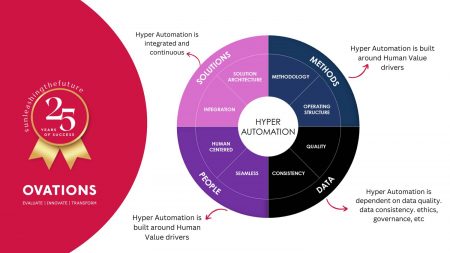 Large organisations strive to achieve growth and success by expanding into new markets, developing new products and services, and participating in mergers and acquisitions. This has led to even larger and more complex organisations with highly interconnected business units, both internally and externally, having to think and operate in silos without sufficient collaboration.
Large organisations strive to achieve growth and success by expanding into new markets, developing new products and services, and participating in mergers and acquisitions. This has led to even larger and more complex organisations with highly interconnected business units, both internally and externally, having to think and operate in silos without sufficient collaboration.
This is where Enterprise Architecture (EA) fits in. EA is:
The discipline of proactively and holistically leading enterprise responses to disruptive forces by identifying and analysing the execution of change toward desired business vision and outcomes. — Gartner, 2020
What this means is that EA provides an opportunity to shift the mindset of an organisation to work top-down, with true enterprise collaboration instead of business unit silos.
Establishing a future-state vision
The EA concept bridges the gap between business strategy and technology. A future-state vision in terms of requirements, principles and models is defined by an EA team that works closely with a company’s business and IT stakeholders. This future-state vision is then compared to the company’s current state to identify gaps and develop road maps to close those gaps. The EA team plays a critical role in aligning your future-state vision to IT investments, enabling business direction while reducing risk and delivering higher-quality information and adaptive solutions. This encompasses cost saving as well by reducing redundancy, duplication and the avoidance of lock-in to proprietary solutions by standardising open methods.
The world we live in is changing at a rapid pace and companies need to keep up. Customers have higher expectations and competition is becoming stiffer with every passing day.
Developing and maintaining an EA is crucial for companies to remain relevant and competitive, along with adapting to new technologies and innovation that bring about benefits that are realised in the long run.
Enterprise Architecture in the Agile environment
With the dynamic changes in the industry and economy, more and more companies are adopting Agile. What this means is more adaptive planning is required to assist the rapid change in execution.
In an Agile enterprise, enterprise architects play a foundational role in collaboration during the planning, architecture and delivery of key transformation initiatives.
Companies adopting Agile typically should have “iteration zero”, where the architectural strategy is laid out, with the low-level design being part of every iteration. This is where Agile and EA meet. During iteration zero, the Agile team can be made aware of the EA goals, EA repositories and shared infrastructure, which could be the base from where the high-level architecture for Agile implementation can be derived. This will prevent the Agile team from creating vertical silos or individual applications, which can sometimes be successful but pose serious challenges in integrating with the rest of the applications in the company’s portfolio and impede the future direction of the company from both technical and business perspectives.
 Elevate the Enterprise Architecture role
Elevate the Enterprise Architecture role
Many companies that have adopted EA to support them in driving business agility and synergies within various business units have failed to derive real value out of EA.
Three reasons why Enterprise Architecture has failed are:
- EA programmes are driven by IT and focus primarily on the technology domain;
- EA is not understood by the business and lacks support; and
- EA is very rigid in its approach and takes a substantial amount of time in delivering value.
To make EA more impactful, its role in the company must be elevated. It needs to be a strategic partner with the business. EA should have more authority to play a governance role and be held accountable for architectural guidance. EA needs to move away from the traditional and lengthy approach of architectural modelling exercises and adopt a new-age, Agile way of working by customising EA frameworks and techniques based on the company’s requirement.
With that said, to further change the perception of EA within companies, enterprise architects need to develop innovative business, not just IT insights, and make them dynamic.
Cloud is the future
Cloud is the foundation for this new Agile business world. It enables companies to rapidly adapt to the changing environment. Companies are now tying digital transformation strategies firmly to a cloud-first approach, not only to save costs from a capex perspective but also to swiftly deliver products and services, in line with the ever-changing customer needs and market dynamics.
Cloud systems have disrupted how businesses operate already. Therefore, having a well-executed EA will make it easier for businesses to manage such inevitable disruption.
Since Enterprise Architecture has overall insight into the company dynamics and a clear understanding of the future vision and strategic road map, it will be wise to drive the cloud-first approach via the EA office.
Some of the new explorative technologies include the shift to cloud services, the adoption of artificial intelligence and machine learning, Internet of things, robotic process automation, and other initiatives. Many organisations are looking to invest in these digital transformations and change initiatives but face challenges when it comes to identifying what suits their needs best. The EA team reduces the complexity associated with digital transformations by running programmes with dedicated staff to establish a plan with ongoing reviews that will provide a clear mandate with well-defined and measurable objectives supporting the company in its transformation journey.
The EA team will also assess business and IT impacts of transformations and translate transformation objectives and customer experiences into architectural changes and initiatives to achieve these objectives.
Strategic road maps
Strategic road maps make planning actionable and track execution throughout the company. They provide insight into what the company needs to achieve to meet strategic goals and, by visualising the work to be done, technology road maps can help bridge the communication gap between technology and business leaders.
One of the key foundations to achieve cloud transformation is to ensure that the company is cloud-ready, and the road map is laid down for the business to seamlessly adopt cloud. Several steps are required to be performed, such as a cloud readiness assessment, setting up landing zones, a migration plan with well-thought-through interdependencies. Here EA plays a key role as it has the widest coverage in the company to rally different teams.
In summary, among all the different teams in a company, the EA team has the overall sight of the varied programmes happening across business units and teams. They are pivoted to connect the dots among the digital initiatives and how they are linked to meeting their strategy and key transformational capabilities such as the cloud journey and modernisation of the IT landscape. EA can provide key insights into the future state of the company and can lay a strong foundation for digital and Agile adoption.
For more, visit ovationsgroup.com, or find the company on Facebook, LinkedIn, Twitter and Instagram.
- Pulkit Kapur is enterprise architect at Ovations Group
- This promoted content was paid for by the party concerned




